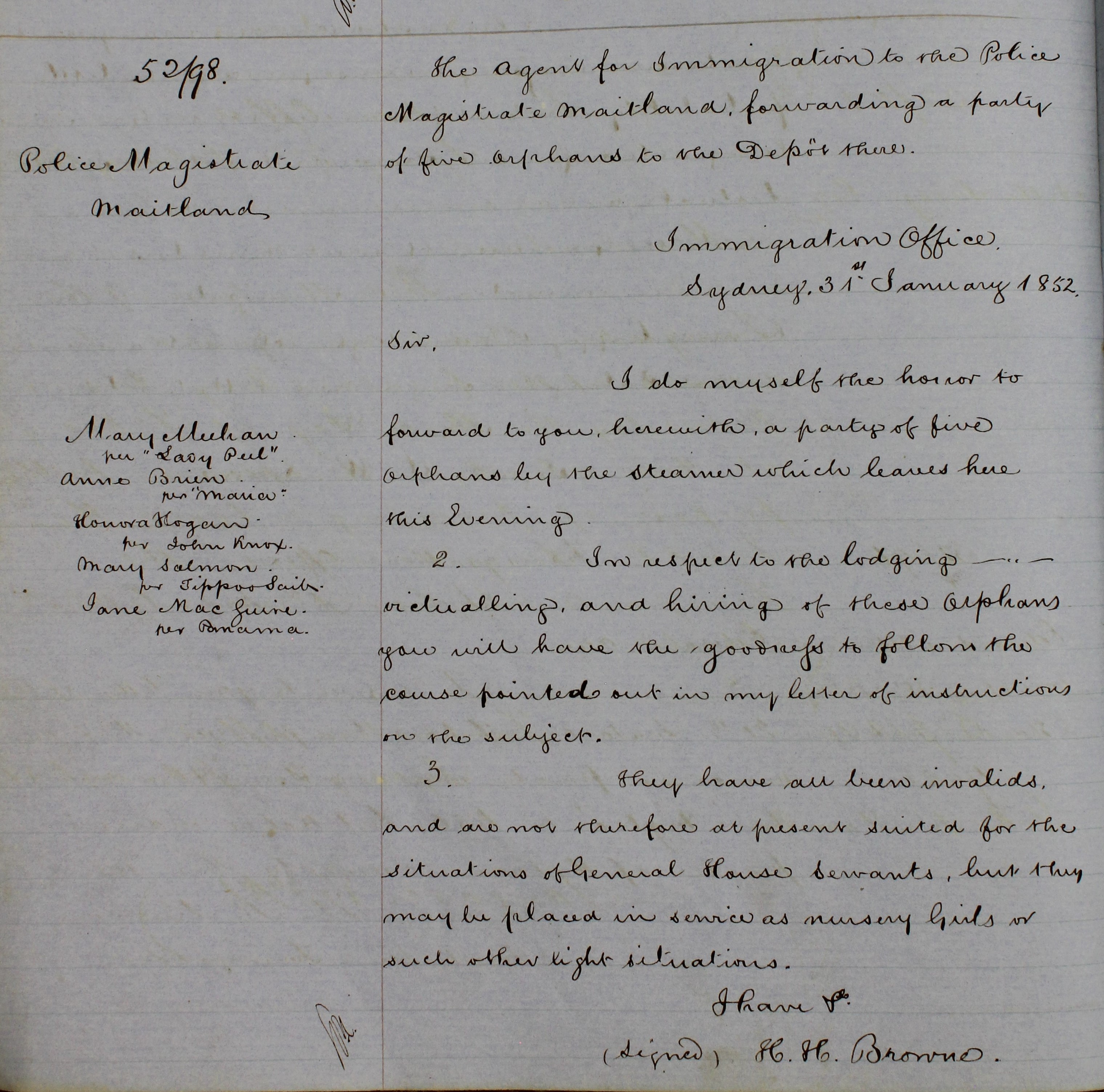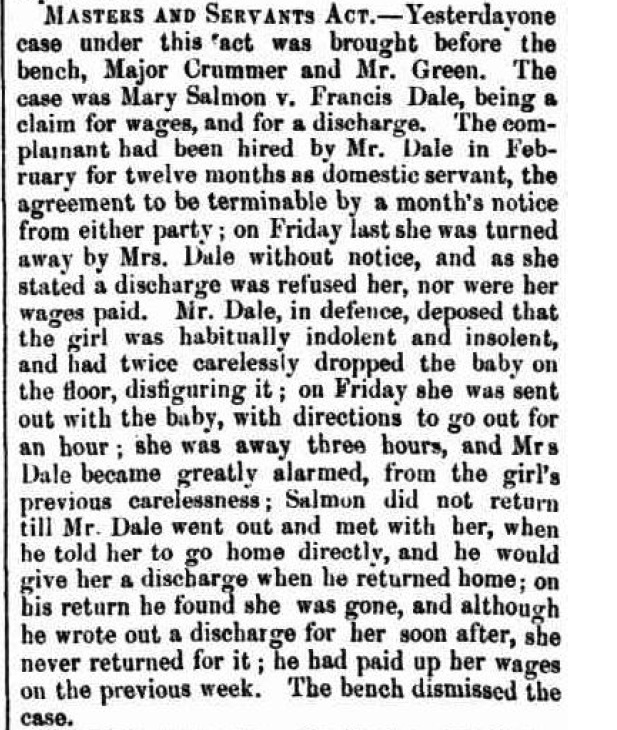Mary Salmon - Irish Orphan
Mary was born about 1836 in Dublin, to William Salmon and Rose Loughlin. She was baptised on 25 April 1836 at Rathfarnham Dublin. Her godparents were James and Anne Moffitt. For more about the Salmon family, please click here .
In 1843 Mary was admitted to the South Dublin Workhouse with her mother, her brothers James and Thomas, and her sisters Martha and Catherine. At this time, Mary's father was listed as in England. The family were discharged from the Workhouse on 29 April 1844.
Mary was admitted to the workhouse again on 7 March 1848. On the same day, at the Meeting of the Board of Guardians, it was agreed that a letter should be sent to Mary's father, who was working for Mr McCracken of Clare (?) ( writing makes it hard to decipher where her father was living/working). Mary was discharged on 30 March 1850. On 8 April 1850, she was one of the "Irish Orphans" on the "Tippoo Saib", which set sail from Plymouth. It landed in Sydney on 29 July 1850. On arrival, the Irish Orphans were placed at the Hyde Park Barracks, pending being placed "in service" (i.e. indentured). How long Mary remained at Hyde Park Barracks is unknown.

Mary Salmon's shipping record
It appears that Mary was first indentured to a Mrs Leeke. At this time, no further details are known about Mrs Leeke, other than she most likely lived in Sydney. It is not known when Mary commenced her indenture with Mrs Leeke. What is known is that on 21 March 1851 the indenture was cancelled for "disobedience". It was quite common for false claims to be made against the Orphan Girls so that the indenture could be cancelled. For an indenture to be cancelled, valid legal grounds for were "insolence", "disobedience", "improper conduct", "absconding" or "neglect of duty" on the part of the apprentice or servant.
In 1855 a New South Wales Parliamentary Enquiry was held as a result of a petition by the Celtic Association. They had complained about comments made by the Immigration Agent, H H Browne, in his 1855 report. Browne stated that Irish female immigrants were unsuitable to the requirements of the Colony, and that they were distasteful to the majority of people. As part of his defence, Browne provided "Return of Cases of Orphan Female Apprentices whose Indentures were cancelled, by the Court of Petty Sessions, at the Water Police Office". The cancellation of Mary Salmon's was one of the many cancellations included in the return. This submission was then included as evidence by the Select Committee on Irish Female Immigration in 1858.

Appendix J Minutes of Evidence taken before the Select Committee on Irish Female Immigration
(Sourced from Trevor McClaughlin's blog post "Earl Grey's Irish Famine Orphans" (22): Cancelled Indentures")
But back to Mary. When indentures were cancelled, orphans were returned to the Hyde Park Barracks, so it can be assumed that this was where Mary returned. The orphans who were returned to the Barracks after their indentures were cancelled were subjected to more severe discipline. On 31 January 1852, Mary was one of five orphan girls transferred from Sydney to Maitland. In the letter from the Agent for Immigration (H H Browne) to the Police Magistrate in Maitland, the agent advised that the girls had all been invalids and "are not therefore at present suited for the situations of General House Servants, but they may be placed in service as nursing girls or such other light situations."

Mary Salmon transferred to Maitland
In February 1852, Mary was hired by Francis Dale, a school master of Maitland, and his wife Grace as a domestic servant. According to the newspaper report below, on 2nd April 1852 Mary was turned away by Mrs Dale, without notice, which breached the agreement between Mary and the Dales. Mary took Francis Dale to court, to claim wages and a discharge. The case was dismissed. At the time, there was a lot of bias against the Irish Orphans, and it also has to be remembered that Francis Dale was on trial, so his claims should not be taken as fact.

Mary Salmon court case
(The Maitland Mercury and Hunter River General Advertiser Wednesday 7 April 1852)
Where Mary went after this is unknown, but it is possible that she was returned to the Immigrant Depot at Maitland. How Mary and Edward Elliott crossed paths is unknown, but they are supposed to have married in Maitland on 26 December 1852. No record of the marriage has been found yet. From information recorded on the birth certificates of their children, the marriage was between 1852 and 1854. Where a full date has been provided, whilst the year varies, the date provided has been consistently 26 December. For further information on the Elliott family, click here.
Mary married Jonathan Watson on 28 August 1873 in Coonabarrabran New South Wales. On her marriage certificate, she states that she was a widow. However there was one small problem, Edward was still alive at the time. He appears to have died in 1879. Children of this marriage were:
- Francis Jonathan Watson (1874 - 1944) married Mary Josephine Dillon
- Robert Watson (1877 - 1936) married Eleanor Jane Terry
- Arthur Richard Watson (1879 - 1938) married Annie May Eldridge
According to the birth certificates for the three Watson boys, Jonathan Watson was born in America. However other evidence suggests that he was born in England. On 9th January 1874, Jonathan was committed to trial at Coonabarrabran, charged with forgery. His trial was held in Mudgee in April 1874. He was found guilty and sentenced to two years hard labour at Darlinghurst Gaol. According to his admission papers, he was born in Liverpool England in 1834, and arrived in New South Wales in 1859 on the "Shamrock".
Family legend has it that Jonathan kicked his stepson, Thomas Elliott, out of the house, when Thomas was about 12 (about 1880). It is unknown if any of his (Elliott) siblings were also kicked out.
In 1886 a warrant was issued by the Bourke Bench for the arrest of Jonathan, he was charged with unlawfully deserting his wife at Dubbo. It was reported that he was accompanied by a boy of about 12 (their son Francis perhaps?) and that he was supposed to have been shearing at Pangee. Nothing more is known about this at this time.
Jonathan died 2 October 1900 and was buried at Rookwood Cemetery. The inscription on his headstone states "late of Girilimbone". This, combined with Jemima being the informant on his death certificate, which also stated that he was late of Girilambone, would suggest that he and Mary had reunited.
A J Watson was listed at Girilambone on the 1891 NSW Census. Mary lived in Girilambone for some years, she was listed as living there on the 1901 NSW Census. When she fell ill she was taken to Nyngan, where she died 31 July 1904, she was buried at Nyngan.
Part of the problem in finding details about Mary had been trying to determine what her maiden name actually was, and her use of "Jemima" in her name. According to her death certificate, her father's name was Alfred Austin. This appears to be one of the many "stories" that have been perpetuated about Mary. Her death certificate also states that she spent some time in Queensland and Tasmania. Whilst I have found evidence of her being in Queensland (her daughter Lillian was born there about 1869), I have not found any evidence of her having lived in Tasmania.
Mary's maiden name provided on the birth certificates of her Elliott children was variations on Salmon/Solomon/Sillilome. Her maiden name on the birth certificates of her Watson children was Austin. This appeared to be supported by Thomas Elliott's death certificate, on which Jemima's maiden name was given as Mary Jemima Austin Salamay. It appears that Mary may have changed some details about her past when she married Jonathan, to hide the fact that she was still legally married to Edward. Mary was the informant on Jonathan Watson's death certificate, she gave her maiden name as Salmon. Please click here for more detailed analysis of Mary's names.
Acknowledgements
With thanks to researchers on Who Do You Think You Are, who found evidence that Edward Elliott was still alive when Mary married Jonathan Watson, and who helped to prove that Mary was in fact Mary Salmon.
With thanks also to Trevor McClaughlin, and his blog Trevo's Irish Famine Orphans (click here to visit his blog. Trevor's site contains a wealth of information and case studies about the Irish Orphans and the times in which they lived, as well as his suggestions to put sources into context and allow for bias and prejudice.